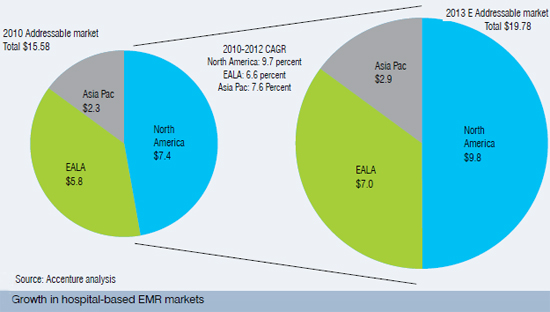
By Malav Kapadia, Vice President, Sales, HealthFore
 Around the world, electronic medical records (EMRs) are being implemented to improve patient care, reduce health care expenses and fundamentally change the way in which medicine is practiced.
Around the world, electronic medical records (EMRs) are being implemented to improve patient care, reduce health care expenses and fundamentally change the way in which medicine is practiced.

According to Accenture, steady growth in hospital-based EMR markets is expected across North America, Europe and Asia Pacific. North America will remain the largest market, growing at a 9.7 percent compound annual growth rate (CAGR) from USD 7.4 billion in 2010 to USD 9.8 billion in 2013. Asia Pacific is projected to grow at 7.6 percent CAGR from USD 2.3 billion to USD 2.9 billion, which is heavily dependent on the evolution of emerging markets, such as India and China.

Looks really enticing for most EMR vendors but we also need to discuss the growing concerns of the medical staff and clinicians and address it.

The perceived advantages of EMRs can be summarised as optimising the documentation of patient encounters, Improves communication amongst healthcare providers, improved clinical decision making, coordinated care delivery, reduction of errors, electronic billing, forming a data repository for research and quality improvement, and reduction of paper significantly.

Despite the high expectations and interest in EMRs world over, overall adoption rate is pretty dismal and riddled with problems. The time is ripe to raise questions about the various myths in implementing EMR and how can a healthcare provider steer clear leading to a satisfactory implementation.
Return on Investment
EMR has an impact on so many things within the healthcare organisation, but the impact is difficult to quantify in hard numbers. Many institutes dont have any metrics in place to measure some of the so-called soft costs related to running their organisations like workflow and efficiency gains, patient safety, communication etc. In order to maximise its success, providers must establish the right internal leadership team that can govern the project and create specific and measurable goals among others.

Clinicians are averse to using EMR
Although there is an initial learning curve during the EMR adoption process, an easy-to-use EMR can significantly improve workflows once an EMR is fully implemented. Tools such as dictation software, Mobile apps and customisable templates can help win over even the most technology-adverse docs. Given the time and age, Clinicians are quite tech savvy and would adopt intuitive technology. One of the leading indicators of success is familiarity with where things are located in the system. HealthFore devises a comprehensive training plan which is done through individual hands-on experience with the product to address this.
Security risk
 EMR Vendors are very strict about who can access patient information and give your EMR records protection beyond whats possible with paper records. In order to open an electronic medical record, a medical practitioner needs strict login credentials. The EMR system tracks every time the records are accessed and backs up data in a safe and secure way so that records are always available to you and your doctors when needed. Also, web-based EMR systems protect from disasters, floods, building fires, and any other disasters that could easily destroy paper records.
EMR Vendors are very strict about who can access patient information and give your EMR records protection beyond whats possible with paper records. In order to open an electronic medical record, a medical practitioner needs strict login credentials. The EMR system tracks every time the records are accessed and backs up data in a safe and secure way so that records are always available to you and your doctors when needed. Also, web-based EMR systems protect from disasters, floods, building fires, and any other disasters that could easily destroy paper records.
Data exchange
Applications do not seamlessly exchange data for coordinated care. Interoperability is one of the major issues that worry healthcare providers when investing in an EMR. Most of the current generation of EMRs complies with IHE standards. IHE promotes the coordinated use of established standards to address specific clinical needs in support of optimal patient care. Systems developed in accordance with the IHE initiative communicate better and are easier to implement, and allow healthcare professionals to use information in a more efficient way.
Staff resistance
This is not exactly a myth, but reality. The biggest hindrance to any new implementation may be the resistance to change by both the staff and physicians. Getting staff buy-in from the beginning, accepting their input in the change process, and openly communicating reasons or the business drivers for implementing EMR and overall benefits of the EMRwill often bring them on board more proactively from the start.
Be a part of Elets Collaborative Initiatives. Join Us for Upcoming Events and explore business opportunities. Like us on Facebook , connect with us on LinkedIn and follow us on Twitter , Instagram.
"Exciting news! Elets technomedia is now on WhatsApp Channels Subscribe today by clicking the link and stay updated with the latest insights!" Click here!















